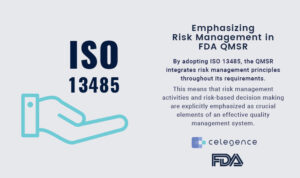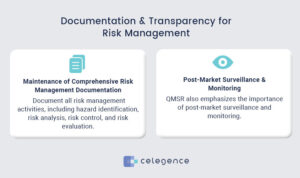Risk Management in Medical Devices: Harmonizing ISO 14971-2019 & FDA QMSR

In February 2024, The United States Food and Drug Administration (USFDA) implemented the Quality Management System Regulation (QMSR), marking a significant shift in its approach to medical device oversight. The QMSR replaces the previous Quality System Regulation (QSR) with a more risk-based framework. This signifies a fundamental change in the regulatory philosophy, aligning with international standards like ISO 13485 and ISO 14971:2019.
Importance of Risk Management for Medical Devices and IVDs
Ensuring the safety and efficacy of medical devices/IVDs is paramount in the healthcare industry. This critical objective is achieved through comprehensive risk management practices, and two key frameworks play a crucial role: ISO 14971:2019 and the FDA Quality Management System Regulation (QMSR). This essay explores their individual contributions and how they work synergistically to enhance medical device safety.
To maintain a robust Quality Management System (QMS) that incorporates risk management principles is outlined in ISO 14971:2019. This ensures that risk assessment and mitigation strategies are embedded throughout the entire product lifecycle, from design and development to manufacturing and post-market surveillance.
Emphasizing Risk Management in FDA QMSR
By adopting ISO 13485, the QMSR integrates risk management principles throughout its requirements. This means that risk management activities and risk-based decision making are explicitly emphasized as crucial elements of an effective quality management system. This emphasis is evident in various clauses of ISO 13485, including but not limited to 4.1, 7.1, 7.3, 7.4, 7.5, 7.6, and 8.2, along with certain subclauses within these clauses.

Strategies for Aligning the QMSR with 14971-2019
Risk Management Lifecycle
- All-inclusive Approach: Ensure risk management is integrated throughout the entire product lifecycle, from design and development to manufacturing, post-market surveillance, and risk control activities.
- Continuous Improvement: Regularly review and update risk assessments based on post-market data, complaints, and adverse event reports. This promotes a proactive approach to identifying and mitigating emerging risks.
Risk-Based Decision Making
- Risk Prioritization: Identify and prioritize risks based on their severity and probability of occurrence. This helps allocate resources effectively and focus on the most critical risks first.
- Risk Mitigation Strategies: Implement robust risk control measures to eliminate or minimize risks, such as design changes, safety features, and user training.
- Corrective Action & Preventive Action (CAPA) Process: QMSR requires manufacturers to implement a robust corrective and preventive action (CAPA) process. This process is essential for addressing nonconformities and implementing corrective actions to prevent recurrence. It also includes taking preventive actions to address potential risks before they occur. By implementing an effective CAPA process, manufacturers can identify and mitigate risks in a timely manner, ensuring the ongoing safety and quality of their devices.

Documentation and Transparency
- Maintenance of Comprehensive Risk Management Documentation: Document all risk management activities, including hazard identification, risk analysis, risk control, and risk evaluation. This documentation should be readily available for internal audits and FDA inspections.
- Post-Market Surveillance and Monitoring: QMSR also emphasizes the importance of post-market surveillance and monitoring. Manufacturers are required to establish procedures for monitoring and analysing post-market information, including complaints, adverse events, and other feedback from users. This information is crucial for identifying potential risks and taking appropriate actions to mitigate them.
Key ISO 14971:2019 Takeaways for Manufacturers
- 1. Emphasizing Risk Management: The QMSR recognizes the significance of risk management in ensuring the safety and effectiveness of medical devices. By incorporating risk management principles into the design, manufacturing, and post-market surveillance processes, manufacturers can proactively identify and mitigate potential risks. This leads to the development and availability of high-quality devices that meet regulatory requirements and provide optimal patient outcomes.
- Adhering to Standards for Enhanced Safety: It is important to note that the QMSR is just one aspect of risk management in the medical device industry. Manufacturers should also consider other relevant standards and guidelines, such as ISO 14971, which provides a comprehensive framework for risk management in medical devices. By adhering to these standards and continuously improving their risk management processes, manufacturers can enhance patient safety and contribute to the overall advancement of the medical device industry.
- Proactive Transition to QMSR: Manufacturers with existing products in the US market should proactively prepare for the transition from QSR to QMSR. This includes conducting thorough gap analysis, implementing transition plans with robust timelines, training resources, and conducting mock audits.
References
- Medical Devices; Quality System Regulation Amendments
- ISO 13485:2016 – Medical devices Quality management systems – Requirements for regulatory purposes
- ISO 14971:2019 Medical devices – Application of risk management to medical devices
Article source: MedTech Intelligence









